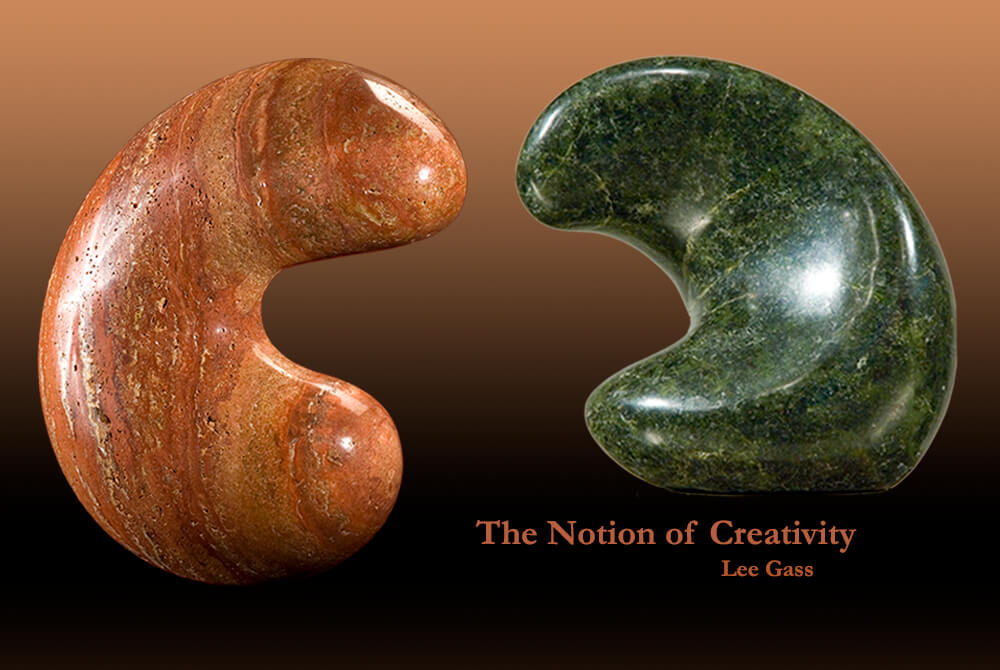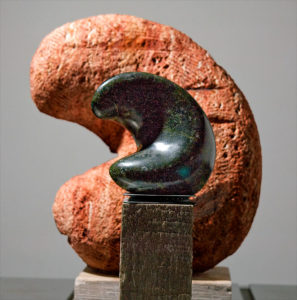The Notion of Creativity
In my work
as a university professor,
questions about where ideas come
from were central to everything I did in
research and teaching. Now as a full-time
sculptor, they are the very essence of my
work. Creativity and innovation are
so important in our culture, and
in every other, and that
makes it good to
understand
them.
Here I will
describe the evolution
of a series of sculptures that began
on a camping trip with my kids on the
Yalakom River in autumn 1983. It rained
the whole time and everything was muddy,
but we kept a nice fire outside our
tent and had a great time.
Since I was soaked
to the bone anyway, it seemed a
good time to wade in the river and look
for rocks. The rich green colour and overall
shape of a hunk of serpentine appealed to me
and I brought it home. During quiet times
on the long drive back I thought about
the rock, held it on my lap,
and visualized its
form.
When we
see faces and elephants
in clouds and stones, psychologists
say we’re projecting experiences of
our own inner lives outward and
imagine seeing them there.
I live my life as a
projectionist.
The rock was still
just a rock on the way home
and for some time after, but it reminded
me of the circle-arrow ‘reload’ ikon in browsers.
Browsers had not yet been invented and only nerds
in universities used the internet. But I knew the
symbol. Maturana used it to indicate the
autopoietic, self-recreating nature
of all living systems.
The shape of a rock
led to a sculpture in serpentine,
Recursion, and pointed to the essence
of human and animal intelligence
and learning. What
a rock!
“Recursion” refers
to recurring, self-referential
processes that modify themselves
each time they occur. Successive cycles
build on each other, ‘recursively’. Smooth,
automatic body temperature regulation
is a simple example of a recursive
process that maintains sta-
bility by changing
itself.
Some systems
are anything but stable.
Anything that happens reinforces
everything else and once it begins, unless
something from the outside gets in the way,
they accelerate to inevitable conclusions
very much different than their
starting points.
In
Falling in Love and
Falling in Hate, everything
reinforces everything else,
things accelerate, get
out of hand, and
climax.
The thrill
of discovery is
similarly explosive.
In research, teaching and
learning, sculpting, ice cream
making, anything else we do.
Most likely, there’s still
something there to
discover.
Within a
few weeks, I had
completed the small green
serpentine Recursion. For the
next 25 years, the whole idea of
recursion grew ever more
central to my work
and to my life.
I fell in love,
felt daily growth in our
relationship, and gave the
sculpture to Lu to symbolize
in celebration of that
recursiveness.
At work, I watched
wild animal and human student
intelligence unfold, learned what I
could learn about how they learn,
recursively, and helped
students learn
creatively.
For years
and decades after, I
dreamed of a return to the
form and the sculpture, larger
and in a different stone. A version of
Recursion resides in a rock I carved.
In my body and in my mind, over
all that time, it transformed.
Recursively.
Waking
fantasies carving stone,
visions of sculptures, dreams at night.
Families of related forms tumbled in space,
seemingly forever, example after
example of the same
basic thing.
Often, those experiences
brought some new insight about
recursiveness, “out there” in the world and
“in here” , experientially. Nearly always
at those times, I thought of carving
another Recursion.
In late summer
2008, a 5-foot column of red
Persian travertine had been standing
at the corner of my studio for years and I’d seen
it every day. Walking around the corner one day,
I suddenly ‘saw’ myself carving a larger Recursion from
a piece of it. I photographed the original from every
side, enlarged the photographs to the scale
of the column, transferred the outlines
to the travertine, cut off a hunk,
and roughed out the
sculpture.
Roughing out,
I realized that working at
a larger scale, and in a different
stone, brought design options I hadn’t
realized in the smaller, darker,
much earlier sculpture
in serpentine.
I made one small change.
One smoothly curving
surface completely covers Recursion
and it has no edges. Red Recursion has
two smoothly curving surfaces and
an abrupt edge between them.
A protected,
everywhere-concave inner
surface curves itself inward in all
directions, like the inside surfaces of
eggshells. On the other side of an
edge, a smooth, mostly convex
outer surface surrounds,
protecting it.
One surface
became two and evolved:
two surfaces and an edge adjusted
themselves to each other.
Recursively.
While carving
Red Recursion, I was
already imagining exploring
the same basic form in what
remained of the column
of travertine.
After Red Recursion,
I stretched a 3-D computer
model of it it upward and
twisted it around in
various ways to
see how it
looked.
Too much
elongation reduced
the sense of self-reference of
either original and any shorter was,
well, squatty. What emerged was a family
of forms related to my Anima series that evoked
the sense of nurturing that some of them
evoke. Anima II and Heart of Anima
are good examples.
Still in the computer,
I made a mirror-image replica
of the stretched, twisted model, made
large prints of both models, and
used them to rough out two
new sculptures in
travertine.
Both were still
in progress when I first
published this article.
That was the
Grand Plan, at least.
After sitting in the garden for
several years, the two stones parted
company, one eventually becoming
Madonna and Child and the
other Reflections.
Among other
things, these sculptures
embody two ways ideas come to me.
Both are important in sculpting and
elsewhere in my life.
Forms remind me
of thoughts and feelings.
Thoughts and feelings remind
me of forms. Those sources of
ideas are closely linked.
I zoom small
forms up to landscape scale
in my mind and imagine traveling
over them, as if riding a motorcycle at high
speed in mountains. Under these imaginary
conditions, I feel forms kinesthetically in
my body rounding bends. I zoom
landscapes down to sculpture
scale and imagine
carving them.
Here is how I expressed
it on my first
business
card.

“My science
and my sculpting are
about forms and patterns of
objects and events. Ultimately they
are about the ‘shape’ of being alive. Perc-
eption, conception, and expression of pattern
are so deeply fundamental that using them in
any domain promotes their development in all
others. Moving my hands over objects in all
directions is exactly what I must do to
carve them! How wonderful
can that be?”
Wonderful
things can occur
when you pick up a
rock and imagine
carving
it!
Methods of Creation?
tells the Yalakom River Story
from the perspective
of creativity.
During a brief
conversation in Amherst
Massachusetts, I learned of some
amazing research on visualization. A
PhD student and her supervisor devised a
difficult computer-based task that required
quick response and accuracy with a mouse
or some other pointing device. It took a
lot of practice to get good at it. Half
of the subjects practiced daily
and the others on alter-
nate days.
On their
‘days off”, alternate-
day subjects stayed home
and imagined practicing for the
same set time. “What difference did
it make?”, I couldn’t help interrupting.
Practicing half the time and visualizing
practicing the other half was almost as
good as practicing full time. They
also told me some professional
sports teams taught players
similar visualization
techniques.
I never
followed through to
see how it developed, and don’t
even remember their names. But their
story reinforced what I was already doing
in sculpting and encouraged me to increase the
visualization training I was already doing with
students at both graduate and undergraduate
levels. It also encouraged a more imagin-
ative way of writing scientific papers,
especially in the scary parts like
speculating on meaning and
extending theory.
First published in the Vancouver Observer.
Edited February 2021













